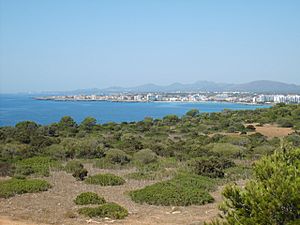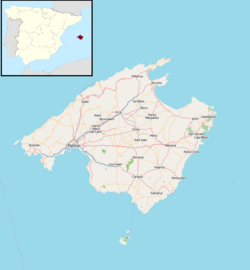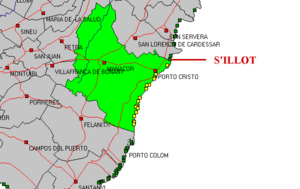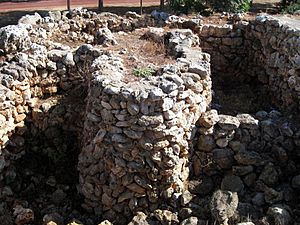S'illot (Mallorca) facts for kids
Quick facts for kids
S'illot
|
|
|---|---|
|
Town
|
|

View of the bay of S'illot and Sa Coma
|
|
| Etymology: Catalan for "islet" | |
| Country | Spain |
| Autonomous Community | Balearic Islands |
| Island | Mallorca |
| Population
(2016)
|
|
| • Total | 1,988 |
S'illot is a small, sunny town on the southeast coast of Mallorca, a beautiful island in Spain. It's a popular spot for tourists and is split between two different local areas: Manacor and Sant Llorenç des Cardassar. A river called Torrent de Ca n'Amer runs through the town, with a big bridge connecting the two parts. S'illot offers many fun activities by the sea. You can also find an old, well-preserved prehistoric village right at the town's entrance.
Contents
Where is S'illot Located?
S'illot is about 63 kilometers (39 miles) east of Palma de Mallorca, the island's capital. It's also 16 kilometers (10 miles) east of Manacor, a larger town. South of S'illot, you'll find the small beach of Cala Morlanda and the wider beach of Cala Moreia. To the north, you'll see the resort of Sa Coma. A rocky piece of land sticks out into the sea between S'illot and Sa Coma.
S'illot is also close to the bigger town of Porto Cristo and other tourist places like Cala Millor. You can easily reach S'illot from Palma and Palma de Mallorca Airport using the MA-15 highway, which goes across the island.
A Brief History of S'illot
The name "Illot" comes from the Catalan language and means "islet" or "small island." This name was chosen because of a little rocky island just off the coast. People lived in this area long ago, even before recorded history. However, they left the site around 200 BC, when the Roman Empire started to take over Mallorca after a big war called the Second Punic War.
Modern S'illot began as a small fishing village. Even today, you can still see fishing boats working from its tiny harbor. In the 1930s, S'illot started to become a summer getaway for people from Manacor. The town began to grow more in 1948 when land was set aside for building. By 1959, S'illot was developing quickly. In 1965, S'illot and Cala Millor together had 19 hotels. Today, Tourism is the main way people in S'illot make a living.
What Can You Do in S'illot?
S'illot is mostly flat, making it easy to walk around. Its main beach is about 350 meters (1,150 feet) long and 50 meters (164 feet) wide. It's a sandy beach that has earned a Blue Flag beach award, meaning it's clean and safe. Along the beach, there's a promenade with many restaurants, cafes, and shops.
At the beach, you'll find lifeguards to keep everyone safe, showers to rinse off, and places to rent sun loungers, umbrellas, and watersports gear. While S'illot has many hotels, it's generally quieter than its neighbor, Sa Coma. Most of the evening fun happens at the hotels. There's also a small supermarket called "aprop" and a place to get tourist information. S'illot is also connected by several bus routes, making it easy to explore.
Who Lives in S'illot?
It's a bit tricky to count the exact number of people living in S'illot because it's part of two different local areas. In 2016, about 243 people lived in the Sant Llorenç part, and 1,745 lived in the Manacor part. However, the Manacor number also includes people from the nearby small resort of Cala Morlanda. Many homes in S'illot are vacation homes, so the number of people in town grows a lot during the summer months.
Exploring the Ancient Village of S'illot
Right inside S'illot, you can visit the remains of an ancient village called Poblat Talaiòtic de s'Illot. The oldest things found here date back to 2200 BC. The main part of the village, a structure called a talaiot, was built around 1100 BC. This site shows us about the Talaiotic culture, which lived on the Balearic islands from the late 2000s BC until the Punic Wars in the late 1000s BC.
About 200 people lived in this village, mostly farming. Hunting and raising pigs and sheep were also very important. In the center of the village was a square talaiot, which was a large stone structure whose exact purpose is still a bit of a mystery. Around it were 35 houses, and the whole village was protected by a defensive wall. The village was left empty in 123 BC when the Romans took over the island.
Between 1960 and 1970, archaeologists from the University of Marburg dug up and studied the site. Today, these ancient remains are in a public area surrounded by houses and hotels. The site is open for everyone to visit. It has walkways, picnic spots, viewing areas, and signs to explain what you're seeing. There's also a visitor center to learn even more.
Other Cool Places to Visit Nearby
- Talaiot de Cala Morlanda – About 690 meters (2,260 feet) south of Cala Moreia, near Cala Morlanda beach, you can find the remains of another talaiot.
- Talaiot de na Pol – This round talaiot is located in the middle of the nearby village of Sa Coma, close to the Safari Park.
- Punta de n'Amer – This headland is a special nature reserve, about 200 hectares (494 acres) in size. It's about two kilometers (1.2 miles) north of S'illot, at the end of the beach promenade. You can explore this beautiful area on many small paths. There's also a castle built in 1696, which used to protect against pirates. It's open to the public and has a small museum, offering great views over the bay of Cala Millor.
- Cuevas del Drach – These amazing limestone caves, also known as "dragon caves," are about seven kilometers (4.3 miles) southeast of S'illot, near Porto Cristo. They stretch over 1,700 meters (5,577 feet) and have six lakes inside. One of them, Martel Lake, is Europe's largest underground lake! You can even enjoy concerts inside the caves.
- Mini Golf Paradis – If you like mini golf, there's a course nearby for some fun.
Fun Events and Festivals in S'illot
- Patron Saint's Day Festival – This festival happens at the end of August and finishes with a fantastic firework show that you can watch from the beach.
- Fiestas de S'Illot – These celebrations take place every year on the second weekend of September.
- Fiestas del Turista – These "Tourist Festivals" were created to make the summer tourist season last longer. They happen every year around the last weekend in September in S'illot, as well as in Cala Millor and Sa Coma.
See also
 In Spanish: S'Illot para niños
In Spanish: S'Illot para niños




